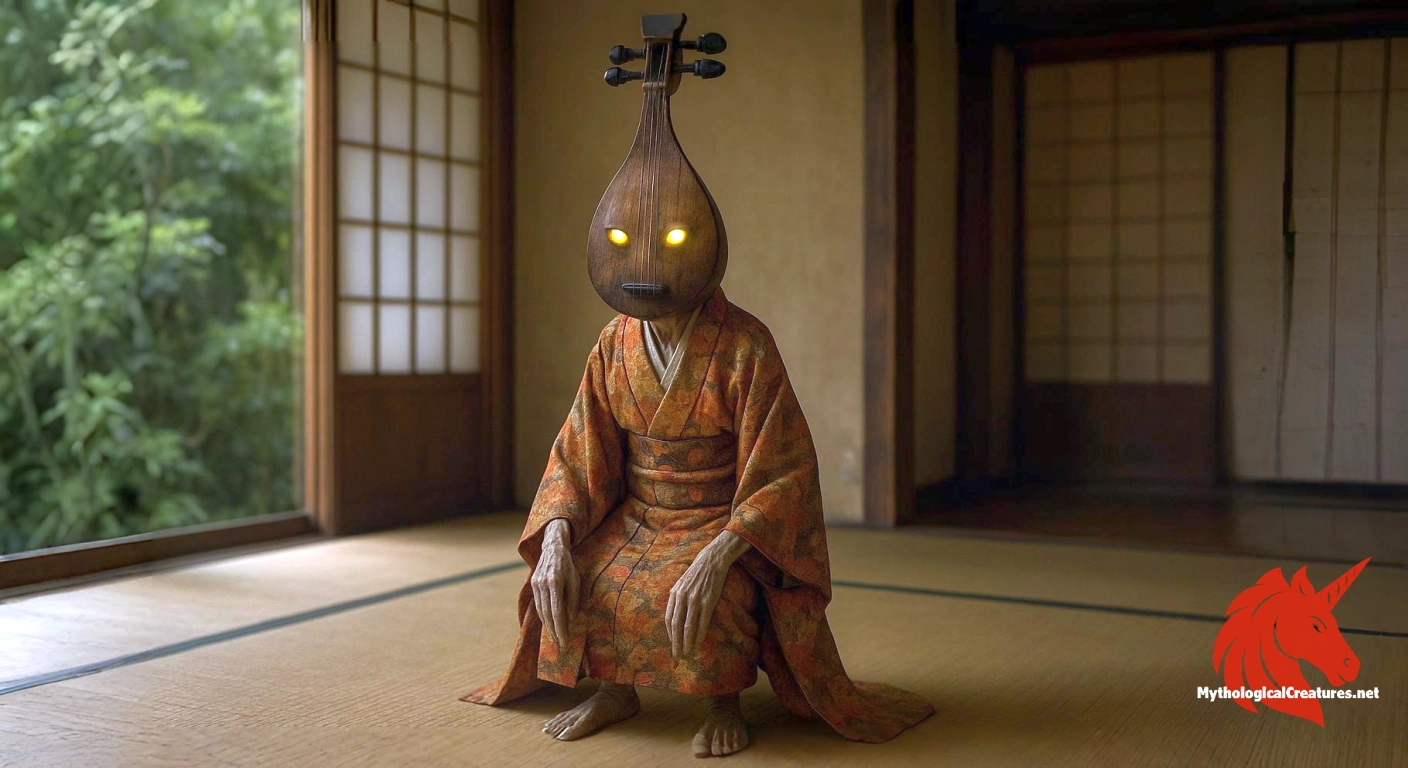Biwa-bokuboku: The Biwa-bokuboku is a yokai from Japanese folklore, known as the Biwa Goblin.

Biwa-bokuboku
Biwa-bokuboku - Embodies the melancholic remembrance of traditional Japanese music and the transient nature of existence, highlighting the nuanced relationship between humans and the supernatural.
Origins & First Encounters
Biwa-bokuboku emerges from the vibrant folklore of Japan as a mysterious spirit whose origins are interwoven with the life of the traditional biwa, a cherished lute. Born from ancient beliefs that everyday objects could acquire souls after long years of use, this enigmatic creature is emblematic of the tsukumogami tradition. Its earliest depictions appear in whimsical Edo period art, where the spirit was both mischievous and melancholic. Over time, the tale of the Biwa-bokuboku evolved into one that reflects the complex interplay between life, art, and the supernatural. It is depicted as an ambivalent character, oscillating between benevolence and trickery, which mirrors the distinctly nuanced nature of many yokai in Japanese cultural narratives. Folk narratives imbue it with a peculiar charm, where humour meets sorrow in unexpected ways. The creature’s story offers insights into a society that revered music and held a deep respect for inanimate objects that had witnessed the passage of time. This layered existence has ensured that its legend endures, inviting modern audiences to rediscover old tales through a contemporary lens.
Source Texts & Tale Variants
Historical accounts of the Biwa-bokuboku are primarily found in Edo period manuscripts and collections of yōkai legends, where its presence is noted in both visual art and succinct narratives. Multiple folklore compilations mention the creature in passing, emphasizing its connection to the biwa and its uncanny ability to come alive. Numerous woodblock prints capture the essence of a ghostly musician whose appearance hints at both whimsy and bemusement. Variants of the legend have been recorded in oral traditions that have been passed down through generations, each adding subtle layers of complexity to its character. Some narratives portray the Biwa-bokuboku as a guardian of forgotten melodies, while others stress its propensity for mischief, comparing its actions to those of a trickster. Despite the scarcity of comprehensive textual sources, the recurring motif of the animated instrument has cemented its place in the broader corpus of tsukumogami lore. Lesser-known regional folklore sometimes offers unexpected variations, blending elements of local myth with the standard narrative. The aggregate of these sources serves as a testament to the enduring fascination with objects that come to life, reflecting a unique blend of reverence and playful admonition.
Form & Powers
The Biwa-bokuboku is usually envisioned as a small, almost pedestrian figure that defies ordinary human dimensions in its spectral charm. It is intrinsically linked to the biwa, which appears not only as an accessory but almost as an extension of its being. Many artistic renditions present it with a gaunt, wizened face that captures a deep, perpetual melancholy, often accentuated by large, reflective eyes that seem to remember lost harmonies. Draped in tattered, traditional robes that evoke the image of an ancient musician, its attire speaks of both decay and a bygone elegance. Intricate details in some illustrations reveal its limbs as strangely flexible, hinting at otherworldly agility and a spirit unbound by physical constraints. The creature’s overall appearance is accentuated by subtle iconography; faint patterns reminiscent of biwa strings sometimes weave across its form. While its physical depictions can vary—with some renditions rendering it nearly human-sized and others more diminutive—the consistent presence of the biwa remains the creature’s defining attribute. Such visual portrayals help to reinforce its identity as an animated spirit of music, blending the ordinary with the supernatural.
Regional Faces
Regional interpretations of the Biwa-bokuboku underscore its chameleon-like ability to adapt to local cultural contexts while retaining its essential mystical nature. In the historic heartlands of Edo, it is often depicted with a wry humour, as a spectral minstrel who both honours and subtly mocks the passage of time. In contrast, rural areas sometimes lend the creature a more benevolent aspect, casting it as a guardian of neglected temples and silent shrines where ancient music still lingers. Certain local stories embellish its character with traits such as altering the tune of its biwa in response to seasonal changes, thereby linking it closely to the natural world. Distinct regional art styles have reinterpreted its figure using varied brushwork and colour palettes, thereby creating unique visual imprints tied to local aesthetics. Some communities even view the Biwa-bokuboku as a symbol of ancestral continuity, a representation of the enduring spirit of cultural heritage. These diverse portrayals highlight the flexible narrative of tsukumogami, where objects are believed to evolve in meaning as they traverse time and space. The regional variations thus contribute to a richer, multi-faceted tapestry of folklore that continues to fascinate and inspire.
Cultural Parallels
When examined alongside other mythological entities, the Biwa-bokuboku vividly illustrates the wider concept of tsukumogami—a tradition in which everyday objects are believed to gain a spirit after years of service. Its story draws parallels with enchanted musical instruments found in various cultures, where the once inanimate is elevated to a vessel of mysterious energies. Similar to the spectral fiddler in European legends whose eerie performances blur the boundary between life and death, the Biwa-bokuboku is celebrated for its delicate balance of mirth and melancholia. This duality is not unique; many cultures possess myths about objects that gain sentience, a shared motif in human storytelling about the power of transformation. The creature’s persistent association with music and memory echoes the universal notion that art holds the power to transcend the temporal realm. In Japanese folklore, its kind is a vivid reminder of the belief that even silent relics can whisper old stories and echo past lives. Comparative studies reveal that while the specifics vary, the core theme of inanimate objects acquiring soul-like qualities resonates globally. This cultural connectivity deepens our understanding of how diverse societies approach the mystery of life within the mundane.
Legacy & Modern Evolution
The Biwa-bokuboku has journeyed from ephemeral Edo period sketches to become a symbol embedded within the modern revival of yokai culture. Its portrayal in historical art has paved the way for contemporary reinterpretations, where it appears not only in literature but also in digital media, anime, and manga. Modern renditions often play up its ambivalent nature, presenting the creature as both a comedic figure and a forlorn spirit caught between worlds. This ongoing transformation speaks to a broader cultural trend that fuses the traditional with the modern, allowing ancient folklore to find a new place in today's entertainment and artistic expression. Its image has evolved into an emblem of the transient beauty and inevitable decay of forgotten melodies and memories. For many, the Biwa-bokuboku encapsulates the bittersweet interplay of nostalgia and innovation that defines modern reinterpretations of myth. Scholars and artists alike continue to explore its symbolism, drawing parallels between its storied past and the complexities of contemporary life. In this way, the legacy of the Biwa-bokuboku not only preserves ancient folklore but also enriches modern cultural dialogue with its timeless mystique.
Interesting Fact
Although not as widely known as some other yokai, the Biwa-bokuboku uniquely fuses the art of traditional music with supernatural folklore, offering a poignant glimpse into the Japanese reverence for ephemeral beauty.
Quick Creature Info
Associations:
Our Mythic Legendary Rating:

Also Sometimes Known As:
Habitat:
Supernatural Powers:
Physical Attributes:
Abilities:
Behavior:
Lore:
Related Creatures, Tales or Lore
- TTsukumogami (possessed objects in Japanese folklore)
- KKitsune (fox spirits in Japanese mythology)
- TTengu (supernatural creatures in Japanese folklore)
References
Discover Another Mythical Legend You May Not Have Heard Of?
Uncover the mysteries of ancient folklore and expand your knowledge of legendary beings from cultures around the world.
Dare to Meet the Suswani Mataji....
Mythical Disclaimer: The images and data on this site are derived from various historical and literary sources, but we have found that many myths often have multiple versions and interpretations across references, sometimes contradictory. As a result, these creature depictions are artistic interpretations—imaginative blends of folklore, legend, and a dash of AI guesswork. Because creature descriptions vary widely, our illustrations and accompanying information represent our best effort to honor mythology while bridging creative gaps. Enjoy these interpretations—just remember, we've done our best to respect the stories and validate available data, but in the realm of mythology, details often shift, imagination leads the way, and nothing is ever set in stone!
Curated by the Mythological Creatures Team (rev. May 2025)
